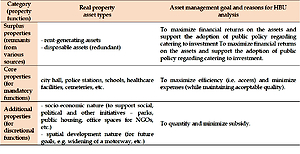Current issue
Online first
Archive
About the Journal
Aims and scope
Editorial Board
International Editorial Board
List of Reviewers
Abstracting and indexing
Ethical standards and procedures
REMV in Social Media
Contact
Instructions for Authors
Instructions for Authors
Manuscript formatting template
Title page
Highlights
Payments
‘Ghostwriting’ and ‘Guestauthorship’
Guidelines for Referees
Reflecting Sustainability in the Analysis of Highest and Best Use: Evidence from Polish Municipalities
1
Departament of Investment and Real Estate, University of Gdansk, Poland
2
Departament of Investment and Real Estate, Nicolaus Copernicus University in Torun, Poland
3
NGL Advisory Sp. z o.o., ul. Koszykowa 61B, 00-667 Warszawa, Poland
Submission date: 2022-07-17
Final revision date: 2022-08-30
Acceptance date: 2022-09-08
Publication date: 2022-12-09
REMV; 2022;30(4):103-115
HIGHLIGHTS
- sustainability dimensions (environmental, economic and social) are embedded to varying extent in individual HBU tests
- in HBU analyses prepared for municipalities, the used sustainability metrics in each of the three dimensions extended beyond those presented so far in the literature
- the metrics used for each sustainability dimension can be divided into external and internal at each of the four HBU tests
KEYWORDS
TOPICS
ABSTRACT
The combination of policy concerns over climate and demographic change, energy shortages, resource efficiency and the natural environment, has led municipalities to be expected to reflect sustainability in different actions, including the decision-making on a considerable amount of their real property assets. As more and more municipalities, use the highest and best use analysis for reviewing the configuration of real property asset portfolio to achieve public goals, this provokes an examination of the reflection of sustainability (environmental, economic and social dimensions) in this kind of elaboration. Thus, this paper aims to investigate how Polish municipalities deal with the incorporation of sustainability into the highest and best use analysis and its operationalization in four tests (legally permissible, physically possible, financially feasible, and maximally productive). The research goal was pursued based on quantitative research using surveys conducted between April and May 2022 among eleven municipalities (creating the largest metropolitan areas in Poland) and qualitative research by the content analysis of HBU analyses prepared for them in previous years.
Share
RELATED ARTICLE
We process personal data collected when visiting the website. The function of obtaining information about users and their behavior is carried out by voluntarily entered information in forms and saving cookies in end devices. Data, including cookies, are used to provide services, improve the user experience and to analyze the traffic in accordance with the Privacy policy. Data are also collected and processed by Google Analytics tool (more).
You can change cookies settings in your browser. Restricted use of cookies in the browser configuration may affect some functionalities of the website.
You can change cookies settings in your browser. Restricted use of cookies in the browser configuration may affect some functionalities of the website.




